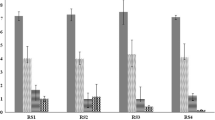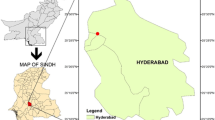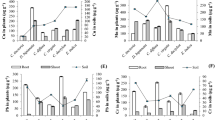Abstract
The phytoremediation is a significant natural clean-up process for removal of heavy metals from wetland saline soils (WS) for the sustainable environmental pollution control. Therefore, the phytoremediation potential of Typha domingensis (southern cattail) and Phragmites australis (common reed) has been evaluated for absorption and accumulation of salts and heavy metals growing at two sites of WS samples coded as BS1 and BS2 (“BS” the soil that is not adjoining to root of plants) in Hyderabad Sindh, Pakistan. The three parts (root, stems, and leaves) of both Plants were obtained from several of locations oxidized the matrices of each part of plants and the corresponding soil samples using acid mixture. A variety of techniques were used to identify the metals by atomic absorption spectrometry. The average values of heavy metals, Co, Cd, Cr, Cu, Pb, and Zn in BS1 and BS2 were found to be (8.53, 14.4, 8.88, 64.3, 13.3, and 142) and (12.4, 18.2, 13.6, 89.4, 14.4, and 124) µg/g, respectively. The data of bioconcentration (BCF) and translocation factors (TF) of the research showed that the studied halophytes showed a high accumulation potential (> 1) for heavy metals from WS. The metal content in plants and rhizospheric soil have a strong relationship (p < 0.01). The screening data based on classical methods and GC–MS indicated that the studied phyto extractants have many phytochemicals. These phytochemicals may have the capability to accumulate heavy metals from contaminated soils. The roots and their rhizospheric soil (RS1 and RS2) have a highly significant relationship of accumulation potential with the selected heavy metals (RS is soil adjoining to roots of plants) (p < 0.01). These halophytes are able to remove heavy metals directly from salty metal-contaminated soil in wetland environments.


Similar content being viewed by others
Data availability
References
Ahmad B, Zaid A, Jaleel H, Khan MMA, Ghorbanpour M (2019) Nanotechnology for phytoremediation of heavy metals: mechanisms of nanomaterial-mediated alleviation of toxic metals. Advances in Phytonanotechnology. Elsevier, pp 315–327
Al-Busaidi A, Yamamoto T, Bakheit C, Cookson P (2006) Soil salinity assessment by some destructive and non-destructive methods in calcareous soils. J Jpn Soc Soil Phys 104:27–40
Ali H, Khan E, Sajad MA (2013) Phytoremediation of heavy metals—concepts and applications. Chemosphere 91(7):869–881
Allotey D, Asiamah R, Dedzoe C, Nyamekye A (2008) Physico-chemical properties of three salt-affected soils in the lower Volta Basin and management strategies for their sustainable utilization. West African journal of applied ecology 12(1)
Ameachi N C, Chijioke CL (2018) Evaluation of bioactive compounds in Pseudarenthemum tunicatum leaves using gas chromatography-mass spectrometry. Evaluation 18(1)
Ashraf MY, Ashraf M, Mahmood K, Akhter J, Hussain F, Arshad M (2010) Phytoremediation of saline soils for sustainable agricultural productivity. Plant adaptation and phytoremediation. Springer, pp 335–355
ASTM A (2007) Standard test methods for moisture, ash, and organic matter of peat and other organic soils. D2974–07.
Bayraklı B, Dengiz O (2020) An evaluation of heavy metal pollution risk in tea cultivation soils of micro-catchments using various pollution indexes under humid environmental condition. Rendiconti Lincei Scienze Fisiche e Naturali 31(2):393–409
Bor M, Özdemir F, Türkan I (2003) The effect of salt stress on lipid peroxidation and antioxidants in leaves of sugar beet Beta vulgaris L. and wild beet Beta maritima L. Plant Sci 164(1):77–84
Chandra R, Yadav S, Yadav S (2017) Phytoextraction potential of heavy metals by native wetland plants growing on chlorolignin containing sludge of pulp and paper industry. Ecol Eng 98:134–145
Coelho, N., Romano, A. (2022). Impact of chitosan on plant tissue culture: recent applications. Plant Cell, Tissue and Organ Culture (PCTOC) 1–13.
Del Buono D, Terzano R, Panfili I, Bartucca ML (2020) Phytoremediation and detoxification of xenobiotics in plants: herbicide-safeners as a tool to improve plant efficiency in the remediation of polluted environments. A Mini-Review. Int J Phytoremediation 22(8):789–803
Dogan M (2019) Effect of cadmium, chromium, and lead on micropropagation and physio-biochemical parameters of Bacopa monnieri (L.) Wettst. cultured in vitro. Rend Lincei. Sci Fis E Nat 30(2):351–366
El-Shehawi AM, Arshi MJB, Elseehy MM, Kabir AH (2022) Sugarcane bagasse acts as a metal absorber in the rhizosphere in mitigating arsenic toxicity in wheat. Rend Lincei. Sci Fis E Nat 33:603–612
Finkemeier I, Sweetlove LJ (2009) The role of malate in plant homeostasis. F1000 Biol Rep. https://doi.org/10.3410/B1-47
Fitz WJ, Wenzel WW, Zhang H, Nurmi J, Štipek K, Fischerova Z, Stingeder G (2003) Rhizosphere characteristics of the arsenic hyperaccumulator Pteris vittata L. and monitoring of phytoremoval efficiency. Environ Sci Technol 37(21):5008–5014
Gupta AK, Sinha S (2008) Decontamination and/or revegetation of fly ash dykes through naturally growing plants. J Hazard Mater 153(3):1078–1087
Haque SA (2006) Salinity problems and crop production in coastal regions of Bangladesh. Pak J Bot 38(5):1359–1365
Hassan IA, Sayegh FA, El-Sheekh MM, Walter JW, El Maghraby DM (2021) Interactive effects of salinity and copper toxicity on the growth and photosynthetic efficiency of germlings and adult brown alga Fucus ceranoides (Fucales, Phaeophyceae). Rend Lincei. Sci Fisiche e Nat 32(4):737–745
Hossain N, Muhibbullah M, Ali KMB, Molla MH (2015) Relationship between soil salinity and physico-chemical properties of paddy field soils of Jhilwanja Union, Cox’s Bazar. Bangladesh J Agric Sci 7(10):166
Imadi SR, Shah SW, Kazi AG, Azooz M, Ahmad P (2016) Phytoremediation of saline soils for sustainable agricultural productivity. Plant metal interaction. Elsevier, pp 455–546
Jadia CD, Fulekar M (2009) Phytoremediation of heavy metals: recent techniques. Afr J Biotechnol 8(6):921–928
Jakkeral SA, Kajjidoni S (2011) Root exudation of organic acids in selected genotypes under phosphorus deficient condition in blackgram (Vigna mungo L. Hepper). Karnataka J Agric Sci 24(3):316–319
Jamali MK, Kazi TG, Afridi HI, Arain MB, Jalbani N, Memon AR (2007) Speciation of heavy metals in untreated domestic wastewater sludge by time saving BCR sequential extraction method. J Environ Sci Health Part A 42(5):649–659
Kamran MA, Mufti R, Mubariz N, Syed JH, Bano A, Javed MT, Chaudhary HJ (2014) The potential of the flora from different regions of Pakistan in phytoremediation: a review. Environ Sci Pollut Res 21(2):801–812
Kerkeb L, Kramer U (2003) The role of free histidine in xylem loading of nickel in Alyssum lesbiacum and Brassica juncea. Plant Physiol 131(2):716–724
Khare S, Singh N, Singh A, Amist N, Azim Z, Bano C, Yadav RK (2022) Salinity-induced attenuation in secondary metabolites profile and herbicidal potential of brassica nigra L. on anagallis arvensis L. J Plant Growth Regul 22:1–6
Kumar V, Kumar P, Eid EM, Singh J, Adelodun B, Kumar P, Choi KS (2021) Modeling of water hyacinth growth and its role in heavy metals accumulation from unoperated old Ganga canal at Haridwar, India. Rend Lincei. Sci Fis E Nat 32(4):805–816
Ladislas S, El-Mufleh A, Gérente C, Chazarenc F, Andrès Y, Béchet B (2012) Potential of aquatic macrophytes as bioindicators of heavy metal pollution in urban stormwater runoff. Water Air Soil Pollut 223(2):877–888
Lal N (2010) Molecular mechanisms and genetic basis of heavy metal toxicity and tolerance in plants. Plant adaptation and phytoremediation. Springer, pp 35–58
Liang L, Liu W, Sun Y, Huo X, Li S, Zhou Q (2017) Phytoremediation of heavy metal contaminated saline soils using halophytes: current progress and future perspectives. Environ Rev 25(3):269–281
Manara A (2012) Plant responses to heavy metal toxicity. Plants and heavy metals. Springer, pp 27–53
Mani D, Kumar C (2014) Biotechnological advances in bioremediation of heavy metals contaminated ecosystems: an overview with special reference to phytoremediation. Int J Environ Sci Technol 11(3):843–872
Milić D, Luković J, Ninkov J, Zeremski-Škorić T, Zorić L, Vasin J, Milić S (2012) Heavy metal content in halophytic plants from inland and maritime saline areas. Cent Eur J Biol 7(2):307–317
Patra DK, Pradhan C, Patra HK (2020) Toxic metal decontamination by phytoremediation approach: Concept, challenges, opportunities and future perspectives. Environ Technol Innov 18:100672
Pedro CA, Santos MS, Ferreira SM, Gonçalves SC (2013) The influence of cadmium contamination and salinity on the survival, growth and phytoremediation capacity of the saltmarsh plant Salicornia ramosissima. Mar Environ Res 92:197–205
Pitman M, Läuchli A, Lüttge U (2002) Salinity: environment-plants-molecules. Läuchli A, Lüttge (eds) Kluwer Academic Publishers, Netherlands pp.3-20
Rosselli W, Keller C, Boschi K (2003) Phytoextraction capacity of trees growing on a metal contaminated soil. Plant Soil 256(2):265–272
Ryu S-K, Park J-S, Lee I-S (2003) Purification and characterization of a copper-binding protein from Asian periwinkle Littorina brevicula. Comp Biochem Physiol C: Toxicol Pharmacol 134(1):101–107
Ryzhenko N, Kavetsky S, Kavetsky V (2017) Cd, Zn, Cu, Pb Co, Ni phytotoxicity assessment as function of its substance polarity shift. Int J Bioorganic Chem 2:163–173
Salazar MJ, Pignata ML (2014) Lead accumulation in plants grown in polluted soils. Screening of native species for phytoremediation. J Geochem Explor 137:29–36
Sharma SS, Dietz K-J (2006) The significance of amino acids and amino acid-derived molecules in plant responses and adaptation to heavy metal stress. J Exp Bot 57(4):711–726
Sharma P, Tripathi S, Chandra R (2020) Phytoremediation potential of heavy metal accumulator plants for waste management in the pulp and paper industry. Heliyon 6(7):e04559
Singh A, Sharma S, Singh B (2017) Effect of germination time and temperature on the functionality and protein solubility of sorghum flour. J Cereal Sci 76:131–139
Tangahu BV, Sheikh Abdullah SR, Basri H, Idris M, Anuar N, Mukhlisin M (2011) A review on heavy metals (As, Pb, and Hg) uptake by plants through phytoremediation. Int J Chem Eng. https://doi.org/10.1155/2011/939161
Ullah R, Bakht J, Shafi M, Iqbal M, Khan A, Saeed M (2011) Phyto-accumulation of heavy metals by sunflower (Helianthus annuus L.) grown on contaminated soil. Afr J Biotechnol 10(75):17192–17198
Ullah R, Alqahtani A (2022) GC-MS analysis, heavy metals, biological, and toxicological evaluation of Reseda muricata and Marrubium vulgare methanol extracts. Evid Based Complement Alternat Med 2022. https://doi.org/10.1155/2022/2284328
Wahla IH, Kirkham M (2008) Heavy metal displacement in salt-water-irrigated soil during phytoremediation. Environ Pollut 155(2):271–283
Wani W, Masoodi KZ, Zaid A, Wani SH, Shah F, Meena VS, Mosa KA (2018) Engineering plants for heavy metal stress tolerance. Rend Lincei. Sci Fis E Nat 29(3):709–723
Wijayawardena MA, Naidu R, Megharaj M, Lamb D, Thavamani P, Kuchel T (2015) Using soil properties to predict in vivo bioavailability of lead in soils. Chemosphere 138:422–428
Wuana R, Okieimen FE (2011) Heavy metals in contaminated soils: a review of sources, chemistry, risks and best available strategies for remediation. Int Sch Res Not 2011:1–20
Zaid A, Mohammad F, Fariduddin Q (2020) Plant growth regulators improve growth, photosynthesis, mineral nutrient and antioxidant system under cadmium stress in menthol mint (Mentha arvensis L). Physio Mol Biol Plants 26(1):25–39
Zhao S, Feng C, Wang D, Liu Y, Shen Z (2013) Salinity increases the mobility of Cd, Cu, Mn, and Pb in the sediments of Yangtze Estuary: relative role of sediments’ properties and metal speciation. Chemosphere 91(7):977–984
Zhuang X, Chen J, Shim H, Bai Z (2007) New advances in plant growth-promoting rhizobacteria for bioremediation. Environ Int 33(3):406–413
Zinicovscaia I, Safonov A, Ostalkevich S, Gundorina S, Nekhoroshkov P, Grozdov D (2019) Metal ions removal from different type of industrial effluents using Spirulina platensis biomass. Int J Phytorem 21(14):1442–1448
Acknowledgements
This work was financially supported by National Centre of excellence in Analytical Chemistry, University of Sindh, Jamshoro.
Author information
Authors and Affiliations
Corresponding author
Ethics declarations
Conflict of interest
All authors have agreed for the submission of current study and have no conflict of interest. It is confirmed that the proposed study is not submitted elsewhere for the publication. On behalf of all authors, the corresponding author states that there is no conflict of interest.
Additional information
Publisher's Note
Springer Nature remains neutral with regard to jurisdictional claims in published maps and institutional affiliations.
Rights and permissions
About this article
Cite this article
Waris, M., Baig, J.A., Talpur, F.N. et al. Estimation of phytoextraction potential of selected halophytes for accumulation of heavy metals from wetland saline soil. Rend. Fis. Acc. Lincei 34, 553–562 (2023). https://doi.org/10.1007/s12210-023-01147-3
Received:
Accepted:
Published:
Issue Date:
DOI: https://doi.org/10.1007/s12210-023-01147-3




